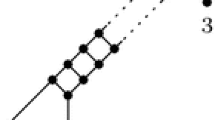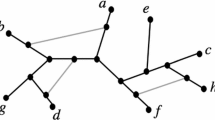Abstract
It is now quite well accepted that the evolutionary past of certain species is better represented by phylogenetic networks as opposed to trees. For example, polyploids are typically thought to have resulted through hybridization and duplication, processes that are probably not best represented as bifurcating speciation events. Based on the knowledge of a multi-labelled tree relating collection of polyploids, we present a canonical construction of a phylogenetic network that exhibits the tree. In addition, we prove that the resulting network is in some well-defined sense a minimal network having this property.
Similar content being viewed by others
References
Bang-Jensen, J., Gutin, G.: Digraphs: theory, algorithms and applications. Springer, 2002
Baroni, M., Grunewald, S., Moulton, M., Semple, C.: Bounding the number of hybridization events for a consistent evolutionary history. J. Math. Biol. 51, 171–182 (2005)
Baroni, M., Steel, M.: Accumulation phylogenies. Ann. Combin. (in press)
Chrochemore, M., Verin, R.: Direct construction of compact directed acyclic word graphs. In: Apostolico, A., Hein, J. (eds.), CPM 1997, LNCS 1264, 1997, pp 116–129
Felsenstein, J.: Inferring phylogenies. Sinauer Associates, Inc, 2003
Gusfield, D., Edduh, S., Langley, C.: The fine structure of galls in phylogenetic networks. To appear in INFORMS J. of Computing Special Issue of Computational Biology
Huber, K.T., Moulton, V.: Phylogenetic networks. In: Gascuel, O. Mathematics of evolution and phylogeny. (ed.) Oxford University Press 2005
Moret, B.M.E., Nakhleh, L., Warnow, T., Linder, C.R., Tholse, A., Padolina, A., Sun, J., Timme, R.: Phylogenetic networks: modelling, reconstructibility, and accuracy. IEEE Transactions on Computational Biology and Bioinformatics 1 (1), 13–23 (2004)
Nakhleh, L., Sun, J., Warnow, T., Linder, C.R., Moret, B.M.E., Tholse, A.: Towards the development of computational tools for evaluating phylogenetic network reconstruction methods. Proceedings of the Eight Pacific Symposium on Biocomputing (PSB'03) 8, 315–326 (2003)
Nakhleh, L., Warnow, T., Linder, C.R.: Reconstructing reticulate evolution in species – theory and practice. In: Proceedings of the Eight Annual International Conference on Research in Computational Molecular Biology (RECOMB'04) 2004, pp 337–346
Popp, M., Erixon, P., Eggens, F., Oxelman, B.: Origin and evolution of a circumpolar polyploid species complex in Silene (Caryophyllaceae) inferred from low copy nuclear RNA polymerase introns, rDNA, and chloroplast DNA. Systematic Botany 30 (2), 302–313 (2005)
Smedmark, J.E.E., Eriksson, T., Evans, R.C., Campbell, C.S.: Ancient allopolyploid formation in Geinae (Rosaceae): Evidence from nuclear granule-bound starch synthase (GBSSI) gene sequences. Systematic Biology 52, 374–385 (2003)
Semple, C., Steel, M.: Phylogenetics. Oxford University Press, 2003
Author information
Authors and Affiliations
Corresponding author
Rights and permissions
About this article
Cite this article
Huber, K., Moulton, V. Phylogenetic networks from multi-labelled trees. J. Math. Biol. 52, 613–632 (2006). https://doi.org/10.1007/s00285-005-0365-z
Received:
Revised:
Published:
Issue Date:
DOI: https://doi.org/10.1007/s00285-005-0365-z




